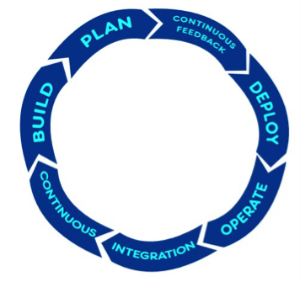 With growing number of ‘connected’ devices, 5G technology promises to deliver accelerated connectivity to consumers along with lucrative services. But it has to complement automated internal operations that will speed up the introduction of new lucrative services delivered through the agile network. NFV (Network Functions Virtualization) and DevOps are the mainstream technology for many IT and telecom based companies. Organizations will be required to refine their business strategy to meet speed and automation expectations along with flexibility, short time to market and cost-effectiveness.
With growing number of ‘connected’ devices, 5G technology promises to deliver accelerated connectivity to consumers along with lucrative services. But it has to complement automated internal operations that will speed up the introduction of new lucrative services delivered through the agile network. NFV (Network Functions Virtualization) and DevOps are the mainstream technology for many IT and telecom based companies. Organizations will be required to refine their business strategy to meet speed and automation expectations along with flexibility, short time to market and cost-effectiveness.
With NFV, network infrastructure has become software-centric by virtualizing core network functions (Firewall, routing, DNS). The word “software” comes into the picture in NFV architecture to represent a code written for developing virtual network functions (VNF) and the model describing infrastructure and execution environment for hosting VNFs. With software approach in NFV, telco and enterprise IT infrastructure using NFV can reduce the cost for network equipment, reduce power consumption, programmable centralized network and shorter time to market for new initiatives for network consumers.
But still, challenges exist in the NFV approach for network service providers. Deployment and configuration of whole NFV infrastructure and make it completely available for delivering all NFV benefits is a complex and time-consuming process. The core of NFV architecture is number of VNFs available and how VNFs are onboarded and aligned with workflows and operational lifecycle management within the infrastructure. To keep up the market competition, service providers want new services i.e. VNFs to be integrated into NFV infrastructure for consumers and existing VNFs will need timely updates. A typical VNF integration has to go through three development cycles at three levels. The solution providers, solution integrators and product environment comprise the NFV infrastructure. Then, the development cycle includes development, testing, onboarding, packaging and deploying at the NFV infrastructure. This whole process requires manual effort, long wait times for developers and the operator involved in pushing services to production as well as backtracking efforts in case things don’t work as per expectation. To overcome this complexity in NFV, there is a need to reduce human intervention, automation of processes, removal of barriers in teams at VNF providers end and service provider’s end and incremental deployment of VNFs.
Here is where DevOps comes into the picture. DevOps is a new culture in software engineering area wherein software development and delivery becomes automated and collaboration and communication established among developers and network infrastructure operators. DevOps provides defined set of methods, tools and platforms for services programming and execution. It includes easy to use SDKs, agile development platforms, test automation tools and reusable libraries. With such benefits in DevOps, by converging DevOps in NFV service providers reduces manual efforts of VNF onboarding and infrastructure configuration by automating processes and increases time-to-market for new services.
When we align DevOps for NFV, we can achieve the following benefits:
- Automatically deploy and testing new updated network services
- Perform testing and benchmarking of NFV infrastructure components
- Achieve performance and reliability policy based fast and resource efficient VNF onboarding, deployment, scaling & resiliency.
- Automatically tuning VNF deployment parameters like the number of CPUs and RAM during deployment or during runtime.
- Real-time checking of expected VNF operational behavior in NFV infrastructure
- Automatically scale and patch resources by real-time monitoring events.
 DevOps approach enables NFV architecture to incorporate Intent Based Networking (IBN) into the NFV ecosystem. Gartner researcher Andrew Lerner wrote about how IBN is going to transition networks. In January 2018, Cisco launched IBN based solution to strengthen the IBN market. IBN is kind of a subset of machine learning, allowing network admins to convey instructions that contain what operation need to be done and what output is expected. In this way, IBN takes DevOps-enabled NFV infrastructure to the next level by translating instructions into action steps and further automating lifecycle management of VNFs and NFV components.
DevOps approach enables NFV architecture to incorporate Intent Based Networking (IBN) into the NFV ecosystem. Gartner researcher Andrew Lerner wrote about how IBN is going to transition networks. In January 2018, Cisco launched IBN based solution to strengthen the IBN market. IBN is kind of a subset of machine learning, allowing network admins to convey instructions that contain what operation need to be done and what output is expected. In this way, IBN takes DevOps-enabled NFV infrastructure to the next level by translating instructions into action steps and further automating lifecycle management of VNFs and NFV components.
Currently, we can say, for 5G networks, NFV is going through development phase where several solution providers will overcome complexities using existing technologies. But service providers or network administrators should keep in mind the future use of machine learning capability enabled with the Intent Based Networking. Having an agile and automated NFV model will set a stage for such luxury for service providers. We can still make IBN case for smaller NFV deployments due to the criticality of operations.
DevOps Tools for VNF onboarding
There are ranges of possible tools available to use for implementing DevOps for VNF onboarding in NFV infrastructure. But CSPs need to decide which are right for their environment.
- Code Management/Version Control: Git, Gitlab
- Issue Management: Jira, Maven
- Test Automation: Selenium
- Binary Management: jFrog Artifactory, Docker Registry
- Scalability logging: vElite Ek
- Monitoring & Automated Recovery: Wily, Dynatrace
- Configuration management tools: Puppet, Salt, Ansible, Chef
- Continuous Integration: Jenkins
- Flexible system deployment: VagrantS
The role of NFV architecture in 5G deployment is extremely crucial. But overall deployment and transition to NFV can be quite challenging in terms of added complexities at the operational and infrastructure deployment levels. With NFV, network functions and operations become programmable, having more APIs enabled and can easily bring them into the DevOps chain. Applying agile software development practices i.e. DevOps to an NFV infrastructure can help service providers to create new services faster and more dynamically to gain a competitive edge and generate revenues.
Sagar Nangare is Digital Strategist at Calsoft Inc. Read more by Sagar on his blog.
